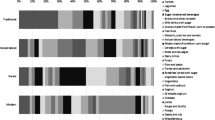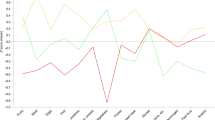Abstract
Objective:
To identify the differences in food habits and preferences among the adolescents according to socio-demographic characteristics.
Design:
Cross-sectional, cluster design survey in 2002.
Setting:
Eight middle schools in two distinct socio-economic areas of the Jiangsu province, China.
Subjects:
Some 824 young adolescents (12–14 y) attending public schools with a response rate of 99%.
Methods:
A self-administered questionnaire containing questions on food and meal frequencies, food preferences and socio-demographic characteristics was used.
Results:
High socio-economic status (SES) and urban residence was positively associated with intake of high-energy foods, such as foods of animal origin, Western style foods and dairy products. In all, 76% of the students had three meals a day regularly , but 8.1% urban students vs 3.4% rural students had breakfast only 1–3 times per week or less often. Daily fruit consumption was fairly common, but with clear differences by SES. Only about 42% of the boys and 55% of the girls from low SES families ate fruit daily, compared with 66% and 72%, respectively in the high SES families. Urban boys had the lowest proportion of daily consumers of vegetables (67.0%). More urban students drank milk daily than the rural students (68.7 vs 38.5%). The frequency of milk drinking also showed a strong positive association with SES. About 10% of the high SES boys consumed hamburgers daily compared with 2.8% of the low SES boys. More than half of the students reported a liking for Western style fast foods including hamburgers, soft drinks and chocolate. Among high SES boys, 21.5% consumed soft drinks on a daily basis; however, as many as 72.3% wanted to drink soft drinks more often if they could afford it.
Conclusions:
SES and urban location were positively associated with frequency of intake of high-energy foods. Reported food preferences may enforce this trend. Nutrition education for adolescents and parents is needed to promote healthy eating. Health Authorities should strengthen the monitoring of food intake and its association with overweight/obesity.
Sponsorship:
This study was funded by the Norwegian Directorate of Health and Social affairs under the auspices of the Norway—China Health Agreement.
This is a preview of subscription content, access via your institution
Access options
Subscribe to this journal
Receive 12 print issues and online access
$259.00 per year
only $21.58 per issue
Buy this article
- Purchase on Springer Link
- Instant access to full article PDF
Prices may be subject to local taxes which are calculated during checkout
Similar content being viewed by others
References
Ahmed F, Zareen M, Khan MR, Banu CP, Haq MN & Jackson AA (1998): Dietary pattern, nutrient intake and growth of adolescent school girls in urban Bangladesh. Public Health Nutr. 1, 83–92.
Ammerman AS, Lindquist CH, Lohr KN & Hersey J (2002): The efficacy of behavioral interventions to modify dietary fat and fruit and vegetable intake: a review of the evidence. Prev. Med. 35, 25–41.
Baranowski T, Cullen KW & Baranowski J (1999): Psychosocial correlates of dietary intake: advancing dietary intervention. Annu. Rev. Nutr. 19, 17–40.
Bellisle F (2004): Impact of the daily meal pattern on energy balance. Scand J. Nutr. 48, 114–118.
Berkey CS, Rockett HR, Gillman MW, Field AE & Colditz GA (2003): Longitudinal study of skipping breakfast and weight change in adolescents. Int. J. Obes. Relat. Metab. Disord. 27, 1258–1266.
Birch LL (1999): Development of food preferences. Annu. Rev. Nutr. 19, 41–62.
Birch LL & Fisher JO (1998): Development of eating behaviors among children and adolescents. Pediatrics 101, 539–549.
Chen J (1999): Dietary changes and disease transition in China. Nutrition 15, 330–331.
Crockett SJ & Sims LS (1995): Environmental influences on children's eating. J. Nutr. Educ. 27, 235–249.
Cruz JA (2000): Dietary habits and nutritional status in adolescents over Europe--Southern Europe. Eur. J. Clin. Nutr. 54 (Suppl 1), S29–S35.
Currie C, Roberts C, Morgan A, Smith R, Settertobulte W, Samdal O & Rasmussen VB (2004): Young people's health in context: health behaviour in school-aged children (HBSC) study: international report from the 2001/2002 study. Copenhagen: World Health Organization.
Currie CE, Elton RA, Todd J & Platt S (1997): Indicators of socioeconomic status for adolescents: the WHO Health Behaviour in School-aged Children Survey. Health Educ. Res. 12, 385–397.
Du L, Ma WJ & Lin YZ (2001): Western pattern fast food consumption and its influencing factors of primary and secondary students in Guang Zhou. Chin. J. School Doctor 15, 403–405.
Durkin MS, Islam S, Hasan ZM & Zaman SS (1994): Measures of socioeconomic status for child health research: comparative results from Bangladesh and Pakistan. Soc. Sci. Med. 38, 1289–1297.
Eriksen K, Haraldsdottir J, Pederson R & Flyger HV (2003): Effect of a fruit and vegetable subscription in Danish schools. Public Health Nutr. 6, 57–63.
French SA & Stables G (2003): Environmental interventions to promote vegetable and fruit consumption among youth in school settings. Prev. Med. 37, 593–610.
Hesketh T, Ding QJ & Tomkins AM (2002): Disparities in economic development in Eastern China: impact on nutritional status of adolescents. Public Health Nutr. 5, 313–318.
Hoglund D, Samuelson G & Mark A (1998): Food habits in Swedish adolescents in relation to socioeconomic conditions. Eur. J. Clin. Nutr. 52, 784–789.
Huang Q (2000): Survey on nutrition knowledge, attitude and diet behavior among school students in Liuzhou City. Chin J. School Health 21, 103–104.
Ji CY (2002): Investigations on the changes of growth and nutritional status of Chinese youths, and the improving strategies and measures upon them. J. Peking Univ. [Health Sci.] 34, 525–529.
Jiangsu Bureau of statistics (2002): Statistical Yearbook of Jiangsu. Beijing: China Statistics Press.
Joshipura KJ, Hu FB, Manson JE, Stampfer MJ, Rimm EB, Speizer FE, Colditz G, Ascherio A, Rosner B, Spiegelman D & Willett WC (2001): The effect of fruit and vegetable intake on risk for coronary heart disease. Ann. Intern. Med. 134, 1106–1114.
Kelder SH, Perry CL, Klepp KI & Lytle LL (1994): Longitudinal tracking of adolescent smoking, physical activity, and food choice behaviors. Am. J. Public Health 84, 1121–1126.
Liberatos P, Link BG & Kelsey JL (1988): The measurement of social class in epidemiology. Epidemiol. Rev. 10, 87–121.
Lien N, Lytle LA & Klepp KI (2001): Stability in consumption of fruit, vegetables, and sugary foods in a cohort from age 14 to age 21. Prev. Med. 33, 217–226.
Ness AR & Powles JW (1997): Fruit and vegetables, and cardiovascular disease: a review. Int. J. Epidemiol. 26, 1–13.
Neumark-Sztainer D, Hannan PJ, Story M, Croll J & Perry C (2003): Family meal patterns: associations with sociodemographic characteristics and improved dietary intake among adolescents. J. Am. Diet. Assoc. 103, 317–322.
O’Dea JA & Caputi P (2001): Association between socioeconomic status, weight, age and gender, and the body image and weight control practices of 6- to 19-year-old children and adolescents. Health Educ. Res. 16, 521–532.
Ortega RM, Requejo AM, Lopez-Sobaler AM, Quintas ME, Andres P, Redondo MR, Navia B, Lopez-Bonilla MD & Rivas T (1998): Difference in the breakfast habits of overweight/obese and normal weight schoolchildren. Int. J. Vitam. Nutr. Res. 68, 125–132.
Prattala RS, Groth MV, Oltersdorf US, Roos GM, Sekula W & Tuomainen HM (2003): Use of butter and cheese in 10 European countries: a case of contrasting educational differences. Eur. J. Public Health 13, 124–132.
Rolland-Cachera MF, Bellisle F & Deheeger M (2000): Nutritional status and food intake in adolescents living in Western Europe. Eur. J. Clin. Nutr. 54 (Suppl 1), S41–S46.
Samuelson G (2000): Dietary habits and nutritional status in adolescents over Europe. An overview of current studies in the Nordic countries. Eur. J. Clin. Nutr. 54 (Suppl 1), S21–S28.
Samuelson G, Bratteby LE, Enghardt H & Hedgren M (1996): Food habits and energy and nutrient intake in Swedish adolescents approaching the year 2000. Acta Paediatr. Suppl. 415, 1–19.
Shaw ME (1998): Adolescent breakfast skipping: an Australian study. Adolescence 33, 851–861.
Shi Z, Lien N, Kumar BN, Dalen I & Holmboe-Ottesen G (in press) The socio-demographic correlates of nutritional status of school adolescents in Jiangsu Province, China. J. Adolesc. Health.
Siega-Riz AM, Carson T & Popkin B (1998): Three squares or mostly snacks—what do teens really eat? A sociodemographic study of meal patterns. J. Adolesc. Health 22, 29–36.
St-Onge MP, Keller KL & Heymsfield SB (2003): Changes in childhood food consumption patterns: a cause for concern in light of increasing body weights. Am. J. Clin. Nutr. 78, 1068–1073.
Steinmetz KA & Potter JD (1996): Vegetables, fruit, and cancer prevention: a review. J. Am. Diet. Assoc. 96, 1027–1039.
Stene LC, Giacaman R, Abdul-Rahim H, Husseini A, Norum KR & Holmboe-Ottesen G (1999): Food consumption patterns in a Palestinian West Bank population. Eur. J. Clin. Nutr. 53, 953–958.
Thang NM & Popkin BM (2004): Patterns of food consumption in Vietnam: effects on socioeconomic groups during an era of economic growth. Eur. J. Clin. Nutr. 58, 145–153.
Wang YM, Mo BQ, Takezaki T, Imaeda N, Kimura M, Wang XR & Tajima K (2003): Geographical variation in nutrient intake between urban and rural areas of Jiangsu province, China and development of a semi-quantitative food frequency questionnaire for middle-aged inhabitants. J. Epidemiol. 13, 80–89.
Wardle J, Jarvis MJ, Steggles N, Sutton S, Williamson S, Farrimond H, Cartwright M & Simon AE (2003): Socioeconomic disparities in cancer-risk behaviors in adolescence: baseline results from the Health and Behaviour in Teenagers Study (HABITS). Prev. Med. 36, 721–730.
WHO/FAO (2003): Diet, Nutrition and the Prevention of Chronic Diseases: Report of a Joint WHO/FAO Expert Consultation.. Geneva: World Health Organization.
Zhao W, Hasegawa K & Chen J (2002): The use of food-frequency questionnaires for various purposes in China. Public Health Nutr. 5, 829–833.
Acknowledgements
We thank the participating Regional Centres for Disease Control and Prevention in Jiangsu Province, including Zhenjiang, Xuzhou, Danyang and Tongshan Centres for their support to the data collection. We also thank Ingvild Dalen for the help in the data analysis.
Author information
Authors and Affiliations
Corresponding author
Additional information
Guarantors: Z Shi and G Holmboe-Ottesen.
Contributors: ZS, NL, BNK, and GH-O contributed to the conception and design of the study. ZS collected and analysed the data, and all authors contributed to the interpretation of the data. ZS drafted the paper and NL, BNK, and GH-O commented upon and revised drafts. All authors gave their approval to the final version submitted for publication.
Rights and permissions
About this article
Cite this article
Shi, Z., Lien, N., Kumar, B. et al. Socio-demographic differences in food habits and preferences of school adolescents in Jiangsu Province, China. Eur J Clin Nutr 59, 1439–1448 (2005). https://doi.org/10.1038/sj.ejcn.1602259
Received:
Revised:
Accepted:
Published:
Issue Date:
DOI: https://doi.org/10.1038/sj.ejcn.1602259
Keywords
This article is cited by
-
Unhealthy lifestyles and clusters status among 3637 adolescents aged 11–23 years: a school-based cross-sectional study in China
BMC Public Health (2023)
-
The Prevalence and Trends of Obesity in Chinese Preschool Children from 1996 to 2019: A Meta-analysis
Journal of Science in Sport and Exercise (2022)
-
Consumption of foods containing prohibited artificial colors among middle-school children in Nay Pyi Taw union territory, Myanmar
BMC Public Health (2019)
-
A comparative study of fruit and vegetable consumption and physical activity among adolescents in 49 Low-and-Middle-Income Countries
Scientific Reports (2018)
-
Behavioral intervention reduces unhealthy eating behaviors in preschool children via a behavior card approach
Journal of Huazhong University of Science and Technology [Medical Sciences] (2016)



